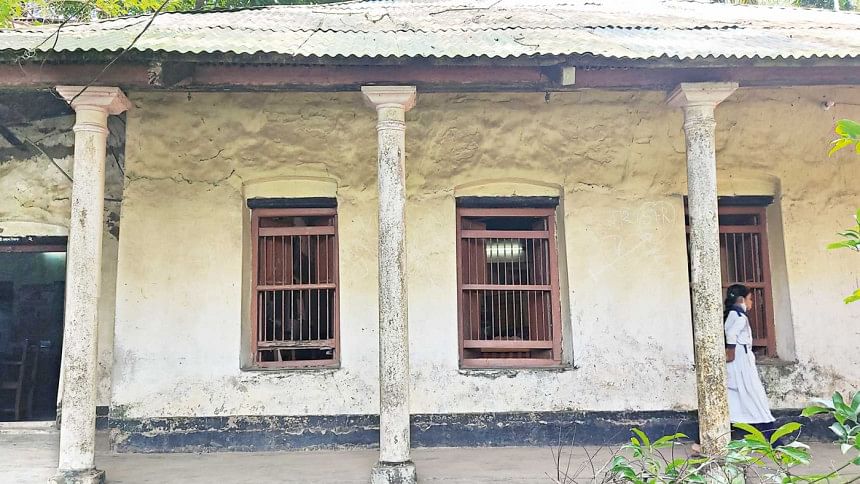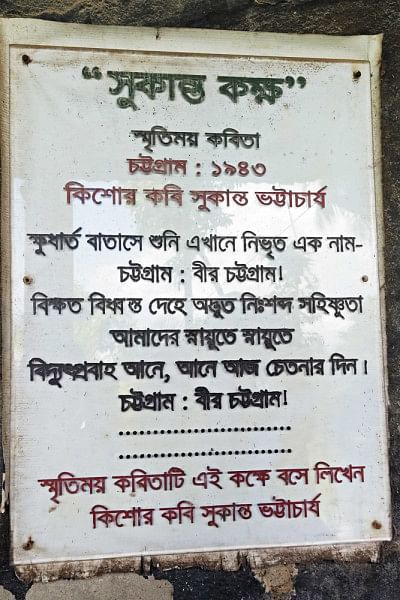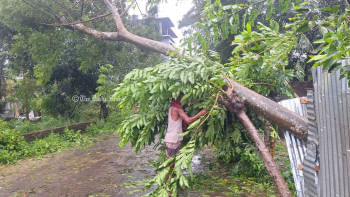A legacy of 105 years


At first glance from the outside, it seems like a typical tin-shed school house set in a village. This seemingly common setup hides the history and legacy of more than a hundred years inside it, which is pretty much evident in its architecture once one steps inside.
Kadhurkhil High School of Boalkhali upazila's Akubdandi village started its journey on January 1, 1917, during the first World War. The 203 feet long and 45 feet wide mud-made school is associated with legendary names from the British era. It's almost as if every nook and corner of the structure holds a bit of history in it, representing this region's transition between a colonised land and an independent state.
The presence of the historical "Parboti Charan Dighi" has increased the beauty of the school even more.
To provide high-school education to the children of the village, educationists of the region established the school. In the beginning, it was only a makeshift room with bamboo fences and mud, on 9 acres of land donated by Prankrishna Chowdhury. Bidhuvushan Chowdhury was the first headteacher of the school.
Sir Bidhuvushan Chowdhury, an All Bengal Teachers Association leader, served as the head teacher of the school from 1917 to 1921 and 1925 to 1957. At first, the school only took admissions for students in the seventh and eighth grades. Later, admissions for higher grades also started.
The original mud-made structure has eight huge rooms, accommodating hundreds of students.
Later, they decided to build the school building just using local materials like Bamboo fences, mud and other raw materials, in solidarity with the Swadeshi Movement. It took around two years to complete the structure from 1918 to 1920. Several buildings were built in the back of the school premises afterwards to accommodate the increasing number of students.
According to the school authority, the school was first recognised by Calcutta University in 1919 and got permanent recognition from the same institute in 1946.
Four students and two teachers from the school became martyrs in the Liberation War in 1971.
During a recent visit to the school, this correspondent saw that room five was marked by the authorities as "Sukanta Room". It was known that renowned poet Sukanta Bhattacharya wrote a poem "Chattogram: 1943" sitting in that very same room.
The education ministry nationalised the school in 2018. Currently, around 906 students have been studying in the school. A total of 13 teachers have been teaching them. The school has an age-old library, where books from the British era are stored.
On December 3, 2015, the school was declared a protected monument by the government for being the longest ancient clay-made structure in the country.
However, during the visit, this correspondent noticed several visible cracks and holes developed on the mud walls. Parts of the bamboo fences on the rooftop were seen falling off at different points.
Students said rainwater leaks from different points of the ceiling during the monsoon.
Md Amir Hossen, senior assistant teacher of the school, told this correspondent, "After issuing a gazette, workers from the archaeology department renovated some parts of the school rebuilding walls before the pandemic."
"The renovation stopped during the pandemic. We have sent several letters to the department but to no avail," he added.
Current headteacher Biswajit Barua said, "We need regular renovation to maintain the structure's archaeological value. We have done that multiple times using the school fund."
Contacted, AKM Saifur Rahman Polin, Chattogram regional director of archaeology department said, "We mostly run renovation works on priority basis. Currently, no renovation is going on at the school. But we hope to initiate it under the plans for the next five years, after visiting the school first."

 For all latest news, follow The Daily Star's Google News channel.
For all latest news, follow The Daily Star's Google News channel. 



Comments